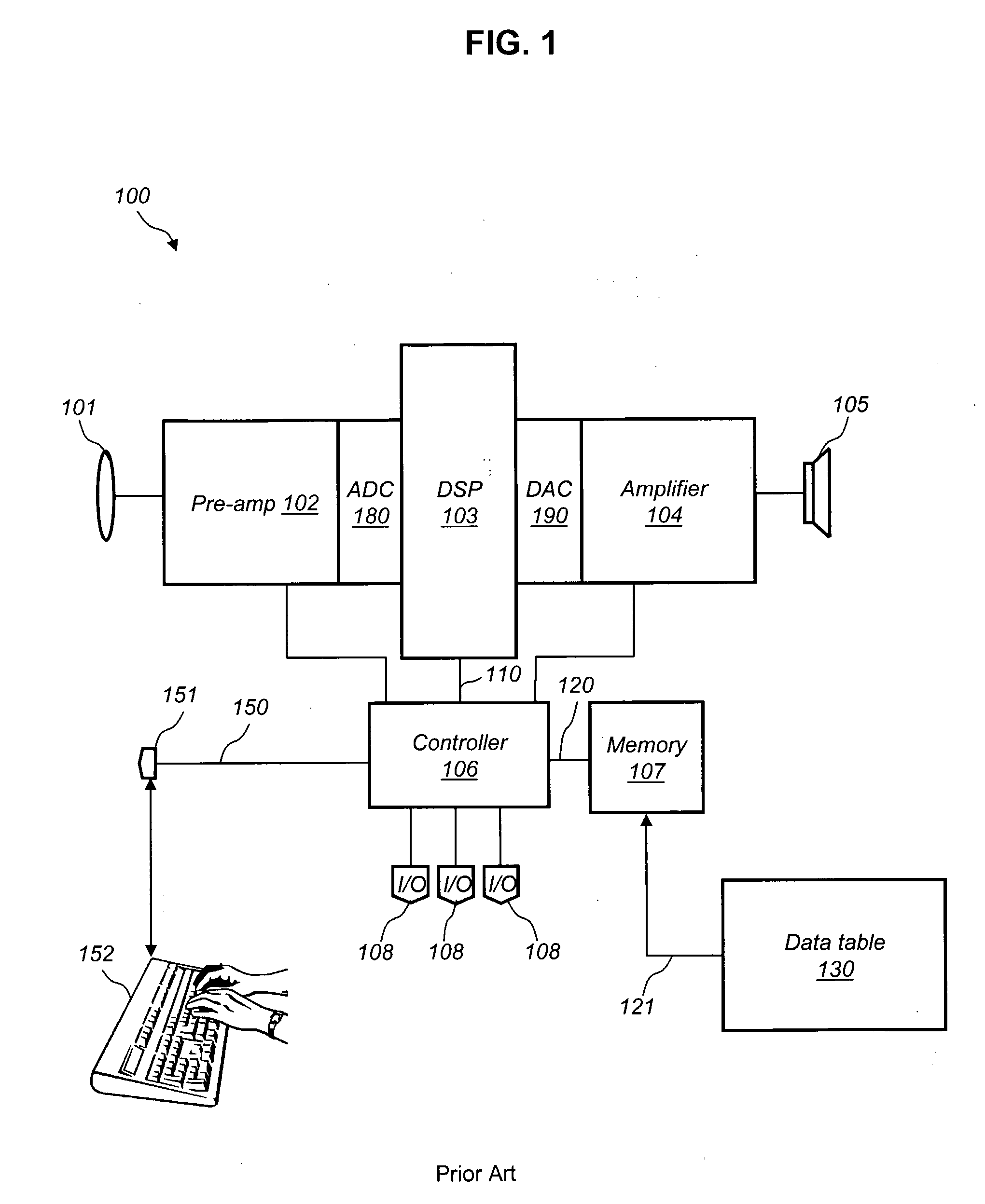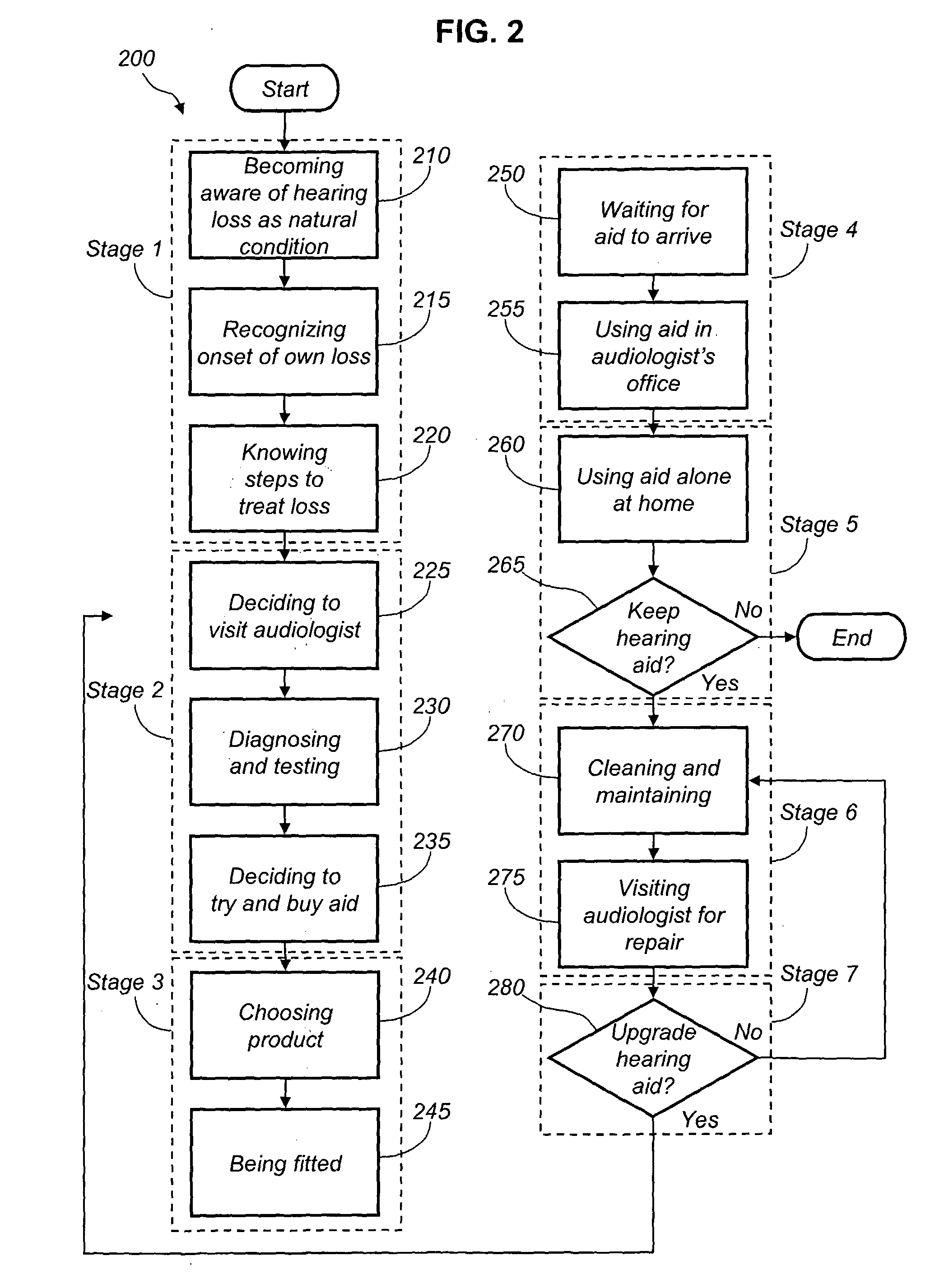Hearing loss can result from infections, strokes, head injuries, some medicines, tumors, other medical problems, or even too much earwax.
It can also result from repeated
exposure to very loud
noise, such as music, power tools, or jet engines.
However, most people do not even know that they have a
hearing loss.
Hearing tests are painless.
If an individual knows he or she has some
hearing loss, the usual reaction is to put off visiting an audiologist because he or she has no idea what having a hearing aid would do to improve his or her
quality of life.
Potential hearing aid users do not have a way to experience what their individual improvement would be if a corrective hearing aid were used.
While the Bekesy method was considered by those skilled in the art of
audiology to be a major advance, it still requires the presence of a skilled operator and the use of rather sophisticated mechanical systems.
However, beyond the individual's reaction to these tones, other factors may influence the individual's hearing needs.
For example, speech intelligibility could be problematic for some individuals, that is, frequency loss in various ranges can severely
impact the individual's ability to understand speech.
Unfortunately, because the individual does not know how the hearing aid will improve his or her hearing, the individual relies solely on the audiologist's recommendations.
At this step, many individuals
delay the decision because of many factors, including price and lifestyle changes.
Unfortunately, the individual has no idea what having a hearing aid would do to improve his or her quality of life.
However, it is difficult to calibrate the exact adjustment of the hearing-aid device to be worn by the
individual based upon the use of
headphones in the hearing test.
A problem associated with the use of
headphones to present tones to the individual is that, due to the unique
acoustics of each individual's
ear canal, the individual's
perception of the sound transmitted by the headphones is different from the individual's
perception of sound transmitted by the actual hearing-aid device in the individual's
ear canal.
After the individual leaves the audiologist and awaits the arrival of the manufactured hearing aid so that it might be fitted, the individual has no way to technically describe to others what his or her hearing loss is, and how it has impacted his or her communication at home and at work.
A new hearing aid initially presents learning challenges that
impact the individual's acceptance of the hearing aid, making the individual likely to return it.
Unlike a prescription for eyeglasses that corrects to near perfect vision, hearing aids do not restore perfect hearing and may require a significant retraining period.
Often, as a person loses his or her hearing within a certain frequency range, certain words become troublesome to hear and the individual continually asks a speaker to repeat the word.
When a new hearing aid is used, the brain no longer recognizes the more correct audio signals because they were replaced by the retrained words that were based upon an incorrect
audio signal presented to it by deficient
hearing ability.
Even after the individual has been trained and has accepted that the hearing aid improves his or her quality of life, other issues
impact the use of hearing aids, for example, the cleaning and maintenance of the hearing aid.
This issue has become even more important as hearing aids have become smaller.
When a hearing aid is inserted into the
ear canal, it is susceptible to the effects of cerumen accumulation and migration.
Cerumen often mixes with sloughed off
skin and
dirt, further impairing the performance of the hearing aid.
Acoustic speakers in most modern hearing aids are particularly susceptible to performance problems and damage from cerumen accumulation; initially, cerumen blocks the speaker port, occluding the acoustic path, in turn preventing sound
waves from reaching the tympanic membrane.
Eventually, the cerumen can penetrate the
receiver housing, damaging the sensitive mechanical and electrical components whose failure necessitates repair or replacement of the hearing aid.
Not only is the cost in time and money significant, but also individuals are uncertain whether their hearing is worsening or the hearing aid is malfunctioning.
The net effect is diminished hearing-aid performance—and thus a diminished quality of life.
While providing some level of protection against cerumen damage to the internal components of the hearing device, this and other similar types of filters become quickly soiled, resulting in poor device performance due to a blocked speaker port.
The small size of these devices often requires a high level of
visual acuity and dexterity for such maintenance.
When users are unsure of or unhappy with their hearing aid's performance, they must bear the inconvenience and cost of taking them to their audiologists for assessment and adjustment.
No in-home means is available by which individuals may test and calibrate their hearing aids to manufacturers' standards, ensuring optimal hearing aid performance; certainly, no such
diagnostic test is generated automatically.
However, the individual still finds it difficult to hear clearly in some instances, such as while watching television, listening to the stereo, going to a
public place such as an opera or a restaurant, etc.
 Login to View More
Login to View More  Login to View More
Login to View More 


